Fertility Testing Devices Market Size
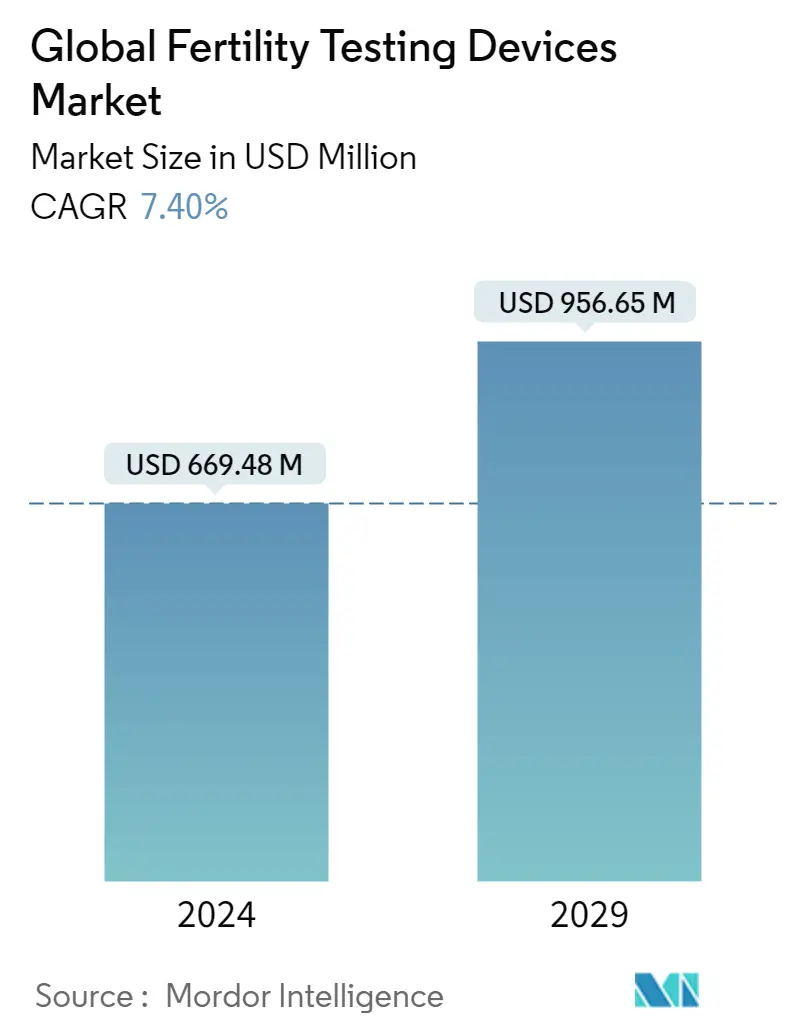
| Study Period | 2019 - 2029 |
| Market Size (2024) | USD 669.48 Million |
| Market Size (2029) | USD 956.65 Million |
| CAGR (2024 - 2029) | 7.40 % |
| Fastest Growing Market | Asia Pacific |
| Largest Market | North America |
Major Players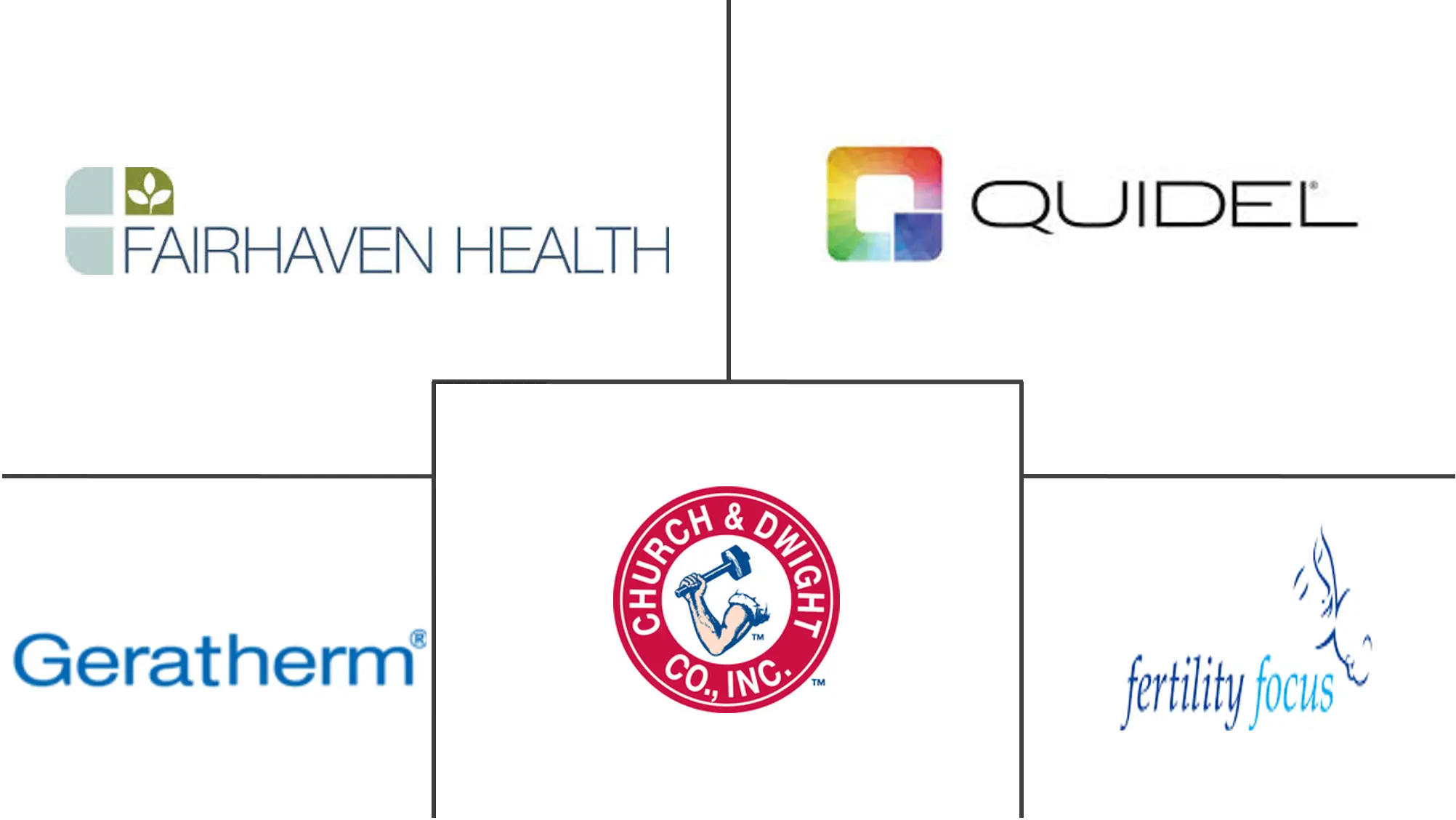
*Disclaimer: Major Players sorted in no particular order |
Fertility Testing Devices Market Analysis
The Global Fertility Testing Devices Market size is estimated at USD 669.48 million in 2024, and is expected to reach USD 956.65 million by 2029, growing at a CAGR of 7.40% during the forecast period (2024-2029).
- The market was negatively impacted by COVID-19 in 2020. Presently the market has now reached pre-pandemic levels. Over the medium term, increasing awareness and favorable government policies and non-government initiatives for curbing air pollution are expected to drive the market's growth.
- On the other hand, the high costs of air quality monitoring systems are expected to hamper the growth of the Asia Pacific air quality monitoring market during the forecast period. Nevertheless, increasing technological advancements in air quality monitoring systems will likely create lucrative growth opportunities for the Asia Pacific air quality monitoring market in the forecast period.
- China dominates the market and is likely to witness the highest CAGR during the forecast period. Increasing awareness of air quality among the public and governments across the country, coupled with supportive government policies.
Fertility Testing Devices Market Trends
This section covers the major market trends shaping the Fertility Testing Devices Market according to our research experts:
Ovulation Prediction Kits are expected to Witness Healthy Growth over the Forecast Period
The pandemic has had mixed effects on the ovulation kit segment. On one hand, due to the luxury of time offered by the lockdowns, many couples planned for a conception during the pandemic. On the other hand, many organizations estimate that the economic crisis during COVID-19, as well as the resulting unemployment, a surge in domestic violence, and restricted access to healthcare during the antenatal period will affect birth rates, resulting in fewer million babies.
Organizations that deal with reproductive health are recommending, out of caution and concern for the lack of data (regarding the relationship between pregnancy and COVID-19), that couples planning pregnancies should hold off for the time being. The European Society of Human Reproduction and Embryology states that all fertility patients considering or planning treatment, even if they do not meet the diagnostic criteria for COVID-19 infection, should avoid becoming pregnant at this time.
OPKs or ovulation prediction kits are used to detect the exact day of ovulation for a woman who is planning for a conception. There are many kinds of ovulation prediction kits in the market. Most of the kits work by measuring the luteinizing hormone (LH) in the urine. LH levels rise 24-36 hours before ovulation. The high level of LH indicates that the release of the egg (ovulation) usually occurs 12-24 hours after the test turns positive.
According to the Centers for Disease Control, one in eight couples has trouble conceiving or sustaining a pregnancy, due to age, health issues, or other factors. This indicates that there is a need in the market for cost-efficient and accurate ovulation monitors. As OPK provides cost-effective fertility testing, its demand is increasing.
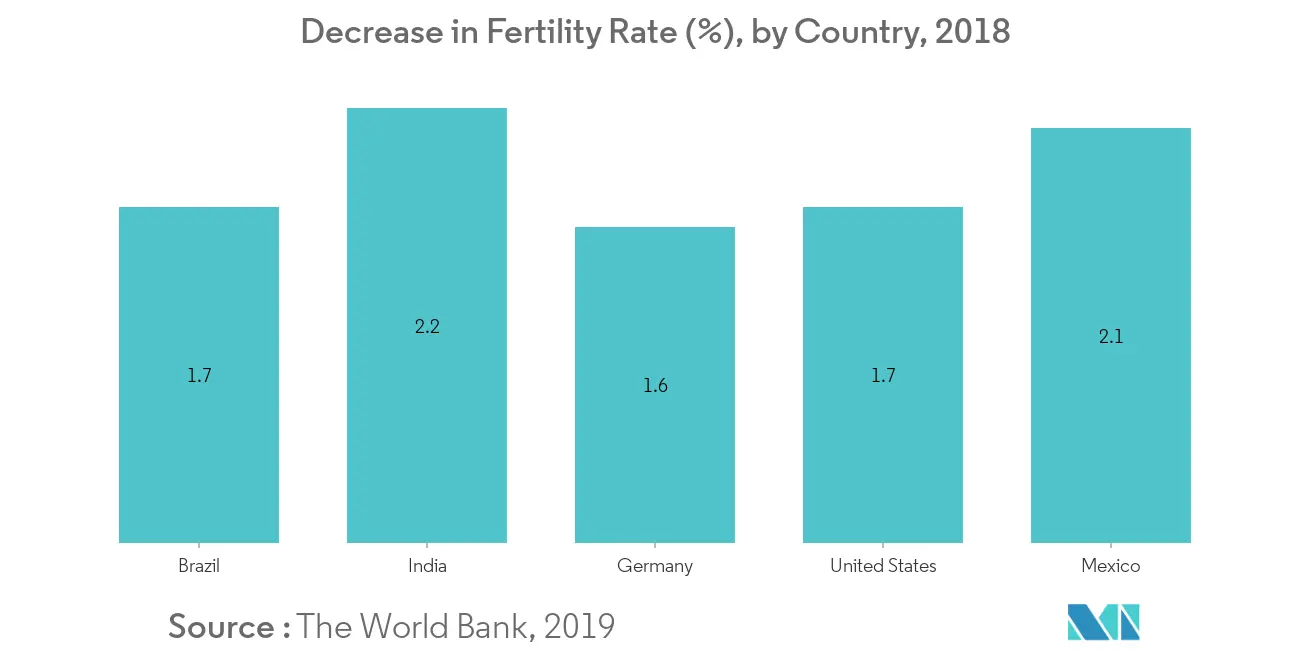
United States holds the Significant Revenue Share in the North America Region
In June 2021, the Brookings Institution estimated that in the United States, public health crisis and associated recession will result in 300,000 to 500,000 fewer births in 2021. According to the Guttmacher Institute survey, 2020, 34% of American women have either delayed their plans to have a child or reduced the number of children they expect to have because of the pandemic.
In 2018, the United States experienced a record low fertility rate. The fertility rate in the United States in 2018 was 1.776 births per woman, a 1.11% decline from 2017 (1.796). The number of births in the country dropped by 2% between 2016 and 2017, to 60.2 births per 1,000 women aged 15-44 years, continuing a general downward trend that started with the Great Recession of 2008. This marks the lowest that the fertility rate of the country has been in 30 years. According to the National Center for Health Statistics (2017), birthrates declined to record lows among all groups under the age of 30. Among women aged 20-24 years, the decline was 4%, whereas for women aged 25-29 years, the rate fell to 2%.
According to CDC, in 2019, about 6% of married women aged 15-44 years in the United States were unable to conceive after one year of trying. Moreover, about 12% of women aged 15-44 years in the United States have difficulty conceiving or sustaining a pregnancy.
Hence, the decreasing fertility rates and rising awareness about fertility testing are driving the fertility testing device market in the country.
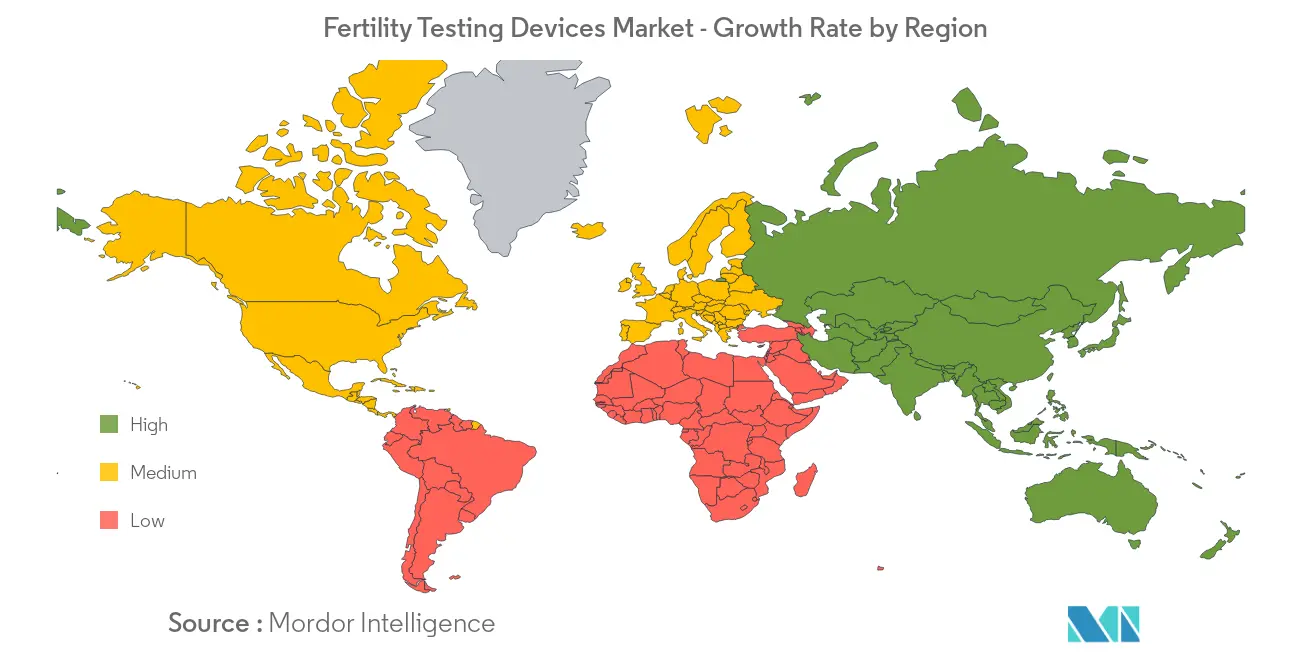
Fertility Testing Devices Industry Overview
The market studied is moderately competitive and there are several local as well as international companies present in the market. Several companies are focusing on the new product launches to sustain their competitiveness and it has been observed that few new companies are entering the market studied, which is increasing the competition.
Fertility Testing Devices Market Leaders
-
Church & Dwight Co., Inc.
-
Geratherm Medical AG
-
Fertility Focus Limited
-
Fairhaven Health, LLC
-
Quidel Corporation
*Disclaimer: Major Players sorted in no particular order
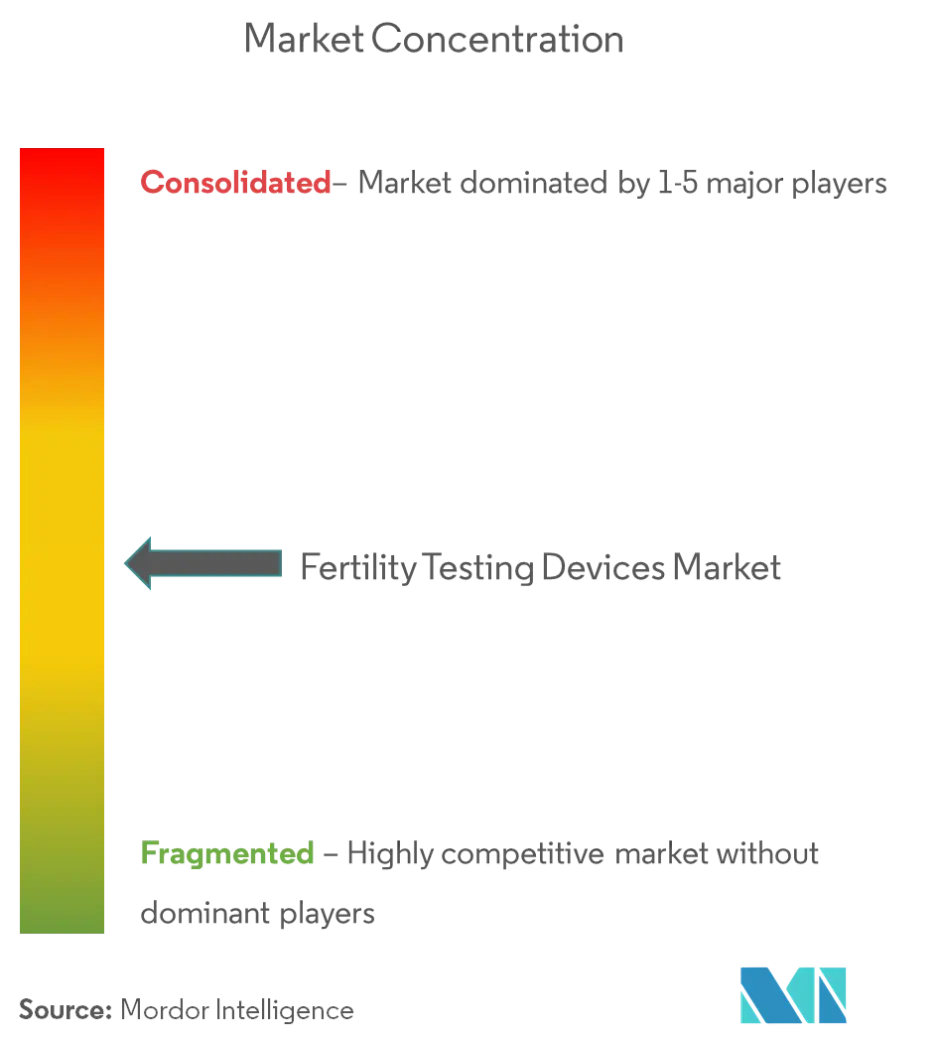
Fertility Testing Devices Market News
- In June 2020, Modern Fertility launched pregnancy and ovulation tests, along with a mobile application to centralize all fertility-related data
- In March 2020, Proov got FDA clearance for its at-home ovulation testing kit.
Fertility Testing Devices Market Report - Table of Contents
1. INTRODUCTION
- 1.1 Study Deliverables
- 1.2 Study Assumptions
- 1.3 Scope of the Study
2. RESEARCH METHODOLOGY
3. EXECUTIVE SUMMARY
4. MARKET DYNAMICS
- 4.1 Market Overview
-
4.2 Market Drivers
- 4.2.1 Decreasing Fertility Rates
- 4.2.2 Rising Awareness about Fertility Testing Devices
- 4.2.3 Launch of Advanced, Easy-to-use Fertility Monitors With High Accuracy
-
4.3 Market Restraints
- 4.3.1 High Price of Ovulation Monitors
- 4.3.2 Lack of Predictive Accuracy to Confirm Ovulation
-
4.4 Porter's Five Forces Analysis
- 4.4.1 Threat of New Entrants
- 4.4.2 Bargaining Power of Buyers/Consumers
- 4.4.3 Bargaining Power of Suppliers
- 4.4.4 Threat of Substitute Products
- 4.4.5 Intensity of Competitive Rivalry
5. MARKET SEGMENTATION
-
5.1 By Product
- 5.1.1 Ovulation Prediction Kits
- 5.1.2 Fertility Monitors
- 5.1.2.1 Urine-based Ovulation Kits
- 5.1.2.2 Saliva-based Ovulation Kits
- 5.1.2.3 Other Fertility Monitors
- 5.1.3 Male Fertility Testing Products
-
5.2 By Mode of Purchase
- 5.2.1 OTC-based
- 5.2.2 Prescription-based
-
5.3 By Application
- 5.3.1 Female Fertility Testing
- 5.3.2 Male Fertility Testing
-
5.4 By End User
- 5.4.1 Home Care Settings
- 5.4.2 Hospitals/Fertility Clinics
-
5.5 Geography
- 5.5.1 North America
- 5.5.1.1 United States
- 5.5.1.2 Canada
- 5.5.1.3 Mexico
- 5.5.2 Europe
- 5.5.2.1 Germany
- 5.5.2.2 United Kingdom
- 5.5.2.3 France
- 5.5.2.4 Italy
- 5.5.2.5 Spain
- 5.5.2.6 Rest of Europe
- 5.5.3 Asia-Pacific
- 5.5.3.1 China
- 5.5.3.2 Japan
- 5.5.3.3 India
- 5.5.3.4 Australia
- 5.5.3.5 South Korea
- 5.5.3.6 Rest of Asia-Pacific
- 5.5.4 Middle East and Africa
- 5.5.4.1 GCC
- 5.5.4.2 South Africa
- 5.5.4.3 Rest of Middle East and Africa
- 5.5.5 South America
- 5.5.5.1 Brazil
- 5.5.5.2 Argentina
- 5.5.5.3 Rest of South America
6. COMPETITIVE LANDSCAPE
-
6.1 COMPANY PROFILES
- 6.1.1 Church & Dwight Co. Inc.
- 6.1.2 Fairhaven Health LLC
- 6.1.3 Fertility Focus Limited
- 6.1.4 Geratherm Medical AG
- 6.1.5 HiLin Life Products Inc.
- 6.1.6 Prestige Brands Holdings Inc.
- 6.1.7 Quidel Corporation
- 6.1.8 Swiss Precision Diagnostics GmbH
- 6.1.9 Advacare Pharma
- 6.1.10 Babystart
- 6.1.11 Biozhena
- 6.1.12 Alere Inc.
- 6.1.13 Procter & Gamble Company
- 6.1.14 Uebe Medical GmbH
- 6.1.15 Samplytics Technologies Private Limited.
- 6.1.16 Tempdrop LLC
- 6.1.17 Valley Electronics
- 6.1.18 PREGMATE
- 6.1.19 Ava Science Inc.
- *List Not Exhaustive
7. MARKET OPPORTUNITIES AND FUTURE TRENDS
** Subject To AvailablityFertility Testing Devices Industry Segmentation
Fertility testing is undertaken by both men and women, for the assessment of their fertility and various conditions associated with it. Both men and women experience fertility problems at equal rates, but women are considered to be more concerned about fertility testing. The market is segmented by product type (ovulation prediction kits, fertility monitors (urine-based ovulation kits, saliva-based ovulation kits, and other fertility monitors), and male fertility products), mode of purchase (OTC-based, prescription-based), application (female fertility testing, and male fertility testing), end-user (home care settings, and hospitals/fertility clinics), and geography (North America, Europe, Asia-Pacific, Middle East & Africa, and South America). The market report also covers the estimated market sizes and trends for 17 different countries across major regions, globally. The report offers the value (in USD million) for the above segments.
| By Product | Ovulation Prediction Kits | |
| Fertility Monitors | Urine-based Ovulation Kits | |
| Saliva-based Ovulation Kits | ||
| Other Fertility Monitors | ||
| Male Fertility Testing Products | ||
| By Mode of Purchase | OTC-based | |
| Prescription-based | ||
| By Application | Female Fertility Testing | |
| Male Fertility Testing | ||
| By End User | Home Care Settings | |
| Hospitals/Fertility Clinics | ||
| Geography | North America | United States |
| Canada | ||
| Mexico | ||
| Geography | Europe | Germany |
| United Kingdom | ||
| France | ||
| Italy | ||
| Spain | ||
| Rest of Europe | ||
| Geography | Asia-Pacific | China |
| Japan | ||
| India | ||
| Australia | ||
| South Korea | ||
| Rest of Asia-Pacific | ||
| Geography | Middle East and Africa | GCC |
| South Africa | ||
| Rest of Middle East and Africa | ||
| Geography | South America | Brazil |
| Argentina | ||
| Rest of South America |
Fertility Testing Devices Market Research FAQs
How big is the Global Fertility Testing Devices Market?
The Global Fertility Testing Devices Market size is expected to reach USD 669.48 million in 2024 and grow at a CAGR of 7.40% to reach USD 956.65 million by 2029.
What is the current Global Fertility Testing Devices Market size?
In 2024, the Global Fertility Testing Devices Market size is expected to reach USD 669.48 million.
Who are the key players in Global Fertility Testing Devices Market?
Church & Dwight Co., Inc., Geratherm Medical AG, Fertility Focus Limited, Fairhaven Health, LLC and Quidel Corporation are the major companies operating in the Global Fertility Testing Devices Market.
Which is the fastest growing region in Global Fertility Testing Devices Market?
Asia Pacific is estimated to grow at the highest CAGR over the forecast period (2024-2029).
Which region has the biggest share in Global Fertility Testing Devices Market?
In 2024, the North America accounts for the largest market share in Global Fertility Testing Devices Market.
What years does this Global Fertility Testing Devices Market cover, and what was the market size in 2023?
In 2023, the Global Fertility Testing Devices Market size was estimated at USD 623.35 million. The report covers the Global Fertility Testing Devices Market historical market size for years: 2019, 2020, 2021, 2022 and 2023. The report also forecasts the Global Fertility Testing Devices Market size for years: 2024, 2025, 2026, 2027, 2028 and 2029.
Global Fertility Testing Devices Industry Report
Statistics for the 2024 Global Fertility Testing Devices market share, size and revenue growth rate, created by Mordor Intelligence™ Industry Reports. Global Fertility Testing Devices analysis includes a market forecast outlook to 2029 and historical overview. Get a sample of this industry analysis as a free report PDF download.



